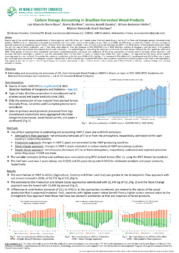Carbon storage accounting in brazilian harvested wood products.
Carbon storage accounting in brazilian harvested wood products.
Autoria: ROSSI, L. M. B.; BORDRON, B.; ZANATTA, J. A.; HOLLER, W. A.; RACHWAL, M. F. G.
Resumo: ABSTRAC. Brazil is one of the world's leading manufacturers of forest products, and 94% of the raw material comes from cultivated forests, mainly of the Pinus and Eucalyptus genera. Harvested wood products (HWP) can be an important carbon pool, based on the estimated carbon stored in the products in use. Thus, as of 2006, the IPCC began to allow the inclusion of these estimates in national inventories of greenhouse gas emissions. However, Brazil only started to consider these removals and carbon emissions by HWP in the 2020 version of the inventory (base year 2016). The primary data of forest production used in this study were obtained from the database of FAO (FAOSTAT) and of IBGE (Brazilian Institute of Geography and Statistics). Only products manufactured with raw material from planted forests were considered. The methodology for calculating the emission and removal of carbon dioxide followed the IPCC guidelines defined in 2006. Three groups of products were considered: sawnwood; wood-based panels; and paper and cardboard. Of the three approaches commonly used to estimate carbon absorption and emission, the most advantageous calculation was the atmospheric flow method, which is based on carbon fluxes rather than stock changes. This approach benefits major wood products exporting countries, such as Brazil. To calculate the estimates, production in the last year (2016) of 13.4 million m3 of sawnwood, 9.63 million m3 of wood panels and 10.3 million tons of paper and cardboard were considered. The estimates obtained indicate that, in 2016 (considering the period 1990-2016), the annual net contribution of forest products estimated by the atmospheric flow approach was the removal of - 50,772 Gg of CO2eq. This removal corresponds to about 3.5% of Brazil's total emissions and 12.8% of LULUCF (Land Use, Land-Use Change and Forestry) activities emissions
Ano de publicação: 2022
Tipo de publicação: Resumo em anais e proceedings
Unidade: Embrapa Florestas
Observações
1 - Por padrão são exibidas publicações dos últimos 20 anos. Para encontrar publicações mais antigas, configure o filtro ano de publicação, colocando o ano a partir do qual você deseja encontrar publicações. O filtro está na coluna da esquerda na busca acima.
2 - Para ler algumas publicações da Embrapa (apenas as que estão em formato ePub), é necessário ter, no celular ou computador, um desses softwares gratuitos. Sistemas Android: Google Play Livros; IOS: iBooks; Windows e Linux: software Calibre.
Acesse outras publicações
Acesse a Base de Dados da Pesquisa Agropecuária (BDPA) para consultar o acervo completo das bibliotecas da Embrapa.

